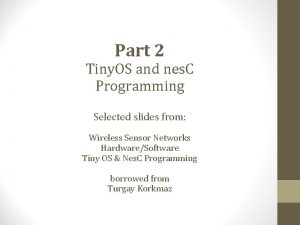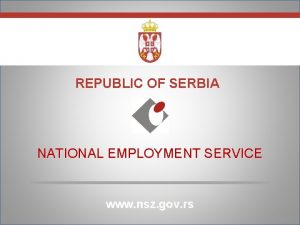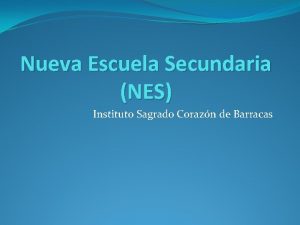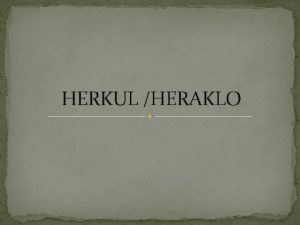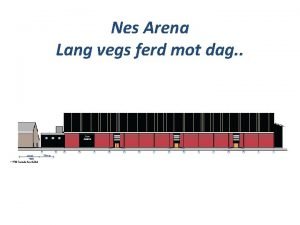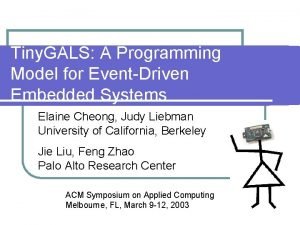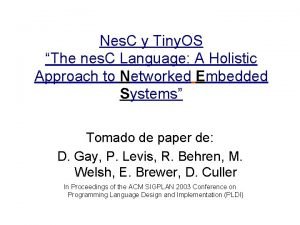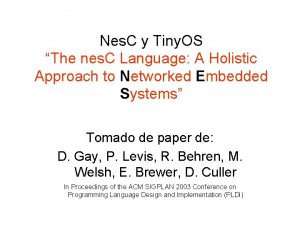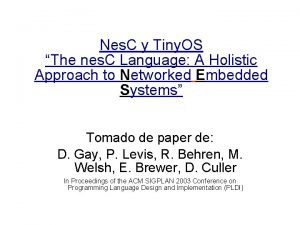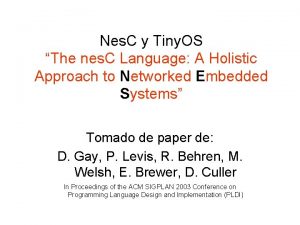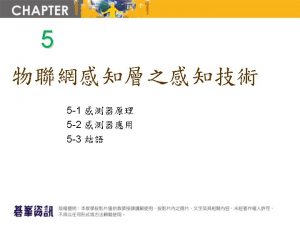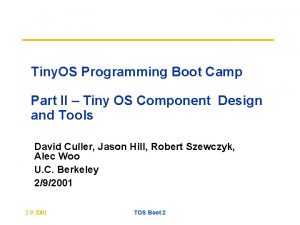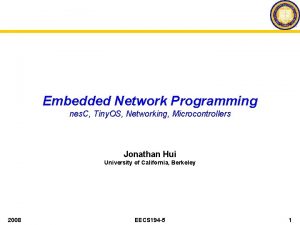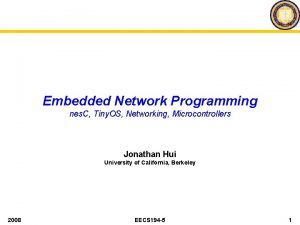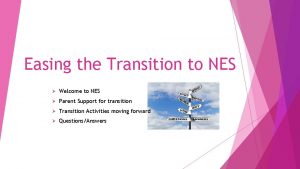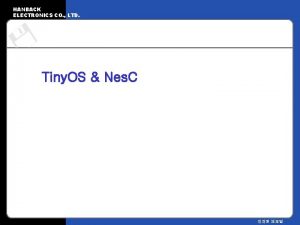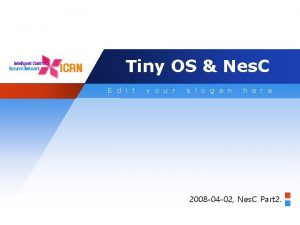Part 2 Tiny OS and nes C Programming














- Slides: 14

Part 2 Tiny. OS and nes. C Programming Selected slides from: Wireless Sensor Networks Hardware/Software Tiny OS & Nes. C Programming borrowed from Turgay Korkmaz

What is Tiny. OS? • Operating system developed by UC Berkeley • Open Source development environment – System, library and applications written in nes. C • nes. C (network embedded system C) a component-based C – Event-driven architecture – Single shared stack – NO kernel, process/memory management – Sleep as often as possible to save power

Programming Model • Basic concept behind nes. C • Separation of construction and composition • Programs are built out of components

Components provides • A component is a black box specified by interface(s) • Interfaces define a set of logically related I/O functions called commands and events • Components use and provide interfaces • Components are statically wired together based on their interfaces Std. Control Timer Component Clock uses Std. Control. nc interface Std. Control { command result_t init(); command result_t start(); command result_t stop(); } Clock. nc interface Clock { command result_t set. Rate( char interval, char scale); event result_t fire(); }

Components (cont’d) • A component – Processes Commands – Throws Events – Has a Frame for local state – Uses Tasks for concurrency • Components must implement – the events they use and – the commands they provide Component Commands Events Provide Must implement Can signal Use Can call Must implement

Commands and Events • commands – deposit request parameters into the frame – are non-blocking {. . . status = call Cmd. Name(args). . . } – need to return status – postpone time consuming work by posting a task command Cmd. Name(args) {. . . return status; } – can call lower level commands • events – can call commands, signal events, post tasks event Evt. Name(args) {. . . return status; } – can Not be signaled by commands – preempt tasks, not vice-versa – interrupt trigger the lowest level events – deposit the information into the frame {. . . status = signal Evt. Name(args). . . }

Component Hierarchy • Components are wired together by connecting users with providers • Commands: – Flow downwards – Control returns to caller • Events: – Flow upwards – Control returns to signaler

Types of Components • There are two types of components: • Modules: provide code that implements one or more interfaces and internal behavior • Configurations: Wires/links components together to yield a new component • A component does not care if another component is a module or configuration • A component may be composed of other components

Component Syntax - module Forwarder. M { provides { interface Std. Control; } uses { interface Std. Control as Comm. Control; interface Receive. Msg; interface Send. Msg; interface Leds; } } implementation { code implementing all provided commands used events, and tasks } uses provides Comm. Control Receive. Msg Std. Control Forwarder. M Send. Msg Leds interface Std. Control { command result_t init(); command result_t start(); command result_t stop(); } interface Send. Msg{ command result_t send(uint 16_t address, uint 8_t length, TOS_Msg. Ptr msg); event result_t send. Done(TOS_Msg. Ptr msg, result_t success); }

Component implementation Command imp. (interface provided) Event imp. (interface used) module Forwarder. M { //interface declaration } implementation { command result_t Std. Control. init() { call Comm. Control. init(); call Leds. init(); return SUCCESS; } command result_t Std. Control. start() {…} command result_t Std. Control. stop() {…} event TOS_Msg. Ptr Receive. Msg. receive(TOS_Msg. Ptr m) { call Leds. yellow. Toggle(); call Send. Msg. send(TOS_BCAST_ADDR, sizeof(Int. Msg), m); return m; } event result_t Send. Msg. send. Done(TOS_Msg. Ptr msg, bool success) { call Leds. green. Toggle(); return success; } }

Component Syntax - Configuration Component Selection Wiring the Components together Forwarder configuration Forwarder { } implementation { components Main, Leds. C; components Generic. Comm as Comm; components Forwarder. M; Main. Std. Control -> Forwarder. M. Std. Control; Forwarder. M. Comm. Control -> Comm; Forwarder. M. Send. Msg -> Comm. Send. Msg[AM_INTMSG]; Forwarder. M. Receive. Msg -> Comm. Receive. Msg[AM_INTMSG]; Forwarder. M. Leds -> Leds. C; } uses provides Std. Control Comm. Control Main Std. Control Receive. Msg Std. Control Forwarder. M Receive. Msg Send. Msg Generic. Comm Send. Msg Leds. C

Lab 3 • The lab is done on the computer : • csmisc 19. cs. chalmers. se • To get a username and password: • do an empty submission in Fire! • Tiny. OS with all sources for libraries and everything is installed at /opt/tinyos-2. 1. 0 • Unpack Rout. tar. gz into your home directory (at the server) and do the assignment from there. • Compile the program by executing: make micaz sim • Run the simulation by executing: . /simulation. py <topology file> • Build topologies using buildtopo. py to get a grid and then remove some nodes to get some interesting formation

Part 1 – improve the basic routing • Implement something better than the basic routing algorithm. • The battery level is something that is known to a node, so feel free to use that in your algorithm. • Report: • Discuss the idea behind your algorithm. • Present results from comparing your algorithm to the original algorithm. • Discuss failed improvements.

Part 2 – Clustered data aggregation • Aggregate information and send it to the sink. • Many nodes in an area send their information to a cluster head, that do the summarization and then sends the aggregate message to the sink. • A simple algorithm to choose cluster head: for every node with a certain probability announces itself to be a cluster head. • Choose the parameters you like: battery level of the node, battery level of neighbors, etc. • A cluster head should not store content for more than 1 round. • Report: • Discuss the idea behind your algorithm. • Present results from comparing your algorithm to your algorithm in part one. • Discuss failed improvements.
 Nes programming
Nes programming Www.nsz
Www.nsz Instituto nes
Instituto nes Zeus i alkmena
Zeus i alkmena Isns masjid
Isns masjid Nes ge
Nes ge Hvam vgs
Hvam vgs Usf chemistry department
Usf chemistry department Tiny gals is a programming model for
Tiny gals is a programming model for Language
Language Perbedaan linear programming dan integer programming
Perbedaan linear programming dan integer programming Greedy algorithm vs dynamic programming
Greedy algorithm vs dynamic programming System programming definition
System programming definition Integer programming vs linear programming
Integer programming vs linear programming Programing adalah
Programing adalah
